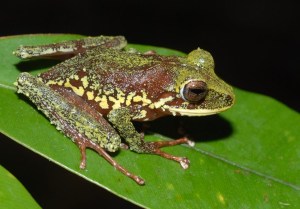
A newly discovered frog in Papua New Guinea (PNG) - Platymantis sp. nov, one of 20 new frogs found by Conservation International. © CI/photo by Stephen Richards
Life always surprises. That’s the lesson that should be taken from the discovery of 200 new plants and animals in the forest-covered mountain of Papua New Guinea. Today the environmental group Conservation International (CI) announced that it had discovered never before seen plants, frogs, mammals, insects and spiders—including several that were so different from existing species that they will create new genera on the taxonomic tree of life. It’s a jackpot of biological discovery, found in one of the most remote territories on the planet—yet one that is still under threat from exploitation. Most of all, though, the CI discoveries are a reminder—much as the Census of Marine Life was—that life on our planet is far more rich, strange and wondrous than we can easily imagine.
The species were discovered as part of CI’s Rapid Assessment Program, an initiative the conservation group launched in 1990 to quickly document the biological value of selected areas. As CI President Russell Mittermeier told me once: “You have to see it to save it”—governments can’t make wise conservation decisions unless they know what might be lost, or saved. This latest survey—done with Papua New Guinea’s Institute for Biological Research (IBR) and A Rocha International, a Christian conservation group—was done in the western Pacific island’s largely unexplored Nakanai Mountains. The mountains are by all accounts spectacular—underground rivers and extensive caves—and the Papua New Guinea government has nominated the area for World Heritage status under the United Nations Education, Scientific and Cultural Organization.
You can go to CI’s website to see a full list of the species found by their scientists, but here’s a list of the highlights:
Yellow-spotted frog (Platymantissp. nov.)
Ceratobatrachid frog (Batrachylodes sp. nov.)
Emerald-green katydid (Mossula sp. nov. 1)
Sharp-legged katydid (Mossula sp. nov.)
(The last species has an interesting defense mechanism—it hold its large and spiny legs vertically above its head and jabs at predators—as a CI scientist found to his discomfort.)
As remote as the Nakanai Mountains are, the rainforest there isn’t safe—subsistence agriculture, loggers and oil palm producers all pose a threat to the sort of unique species CI managed to find in just a brief foray into the wild. And the timing for this announcement isn’t incidental—in a couple of weeks governments will meet in the Japanese city of Nagoya for the 10th conference of the Convention on Biological Diversity, the most important event on the conservation calendar. CI has a goal to protect at least 25% of the planet’s land, and 15% of its water by 2020, but it won’t be easy, as CI Leeanne Alonso, who started RAP, says:
There’s no question that the discoveries we made in both surveys are incredibly significant both for the large numbers of new species recorded, and the new genera identified. While very encouraging, these discoveries do not mean that our global biodiversity is out of the woods. On the contrary, they should serve as a cautionary message about how much we still don’t know about Earth’s still hidden secrets and important natural resources, which we can only preserve with coordinated, long-term management.
Groups like CI help us see nature. Now we need to save it.


